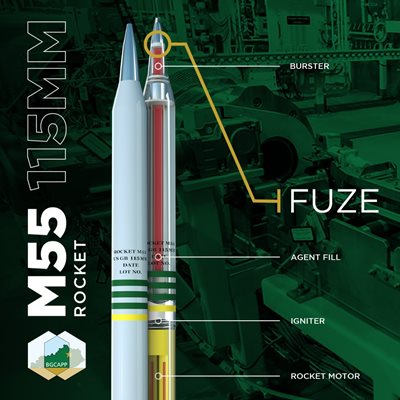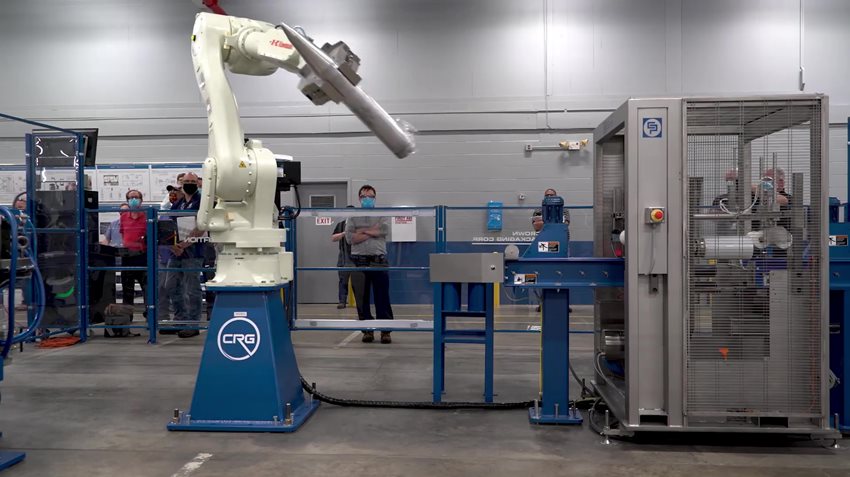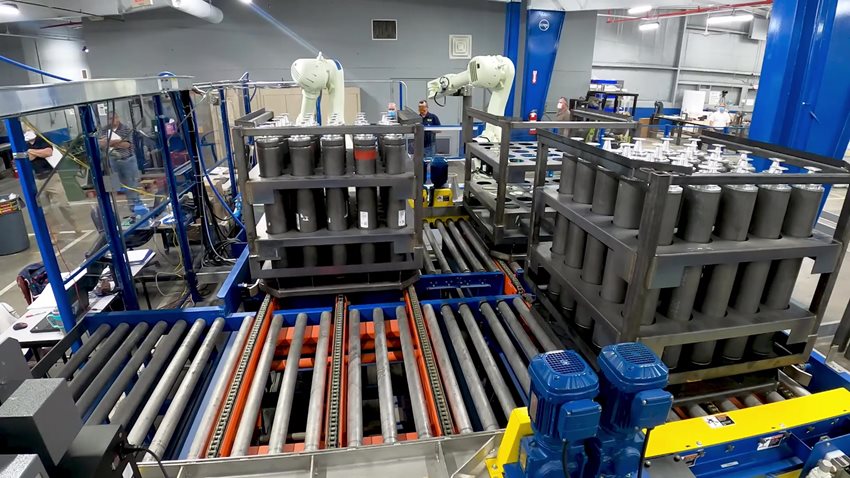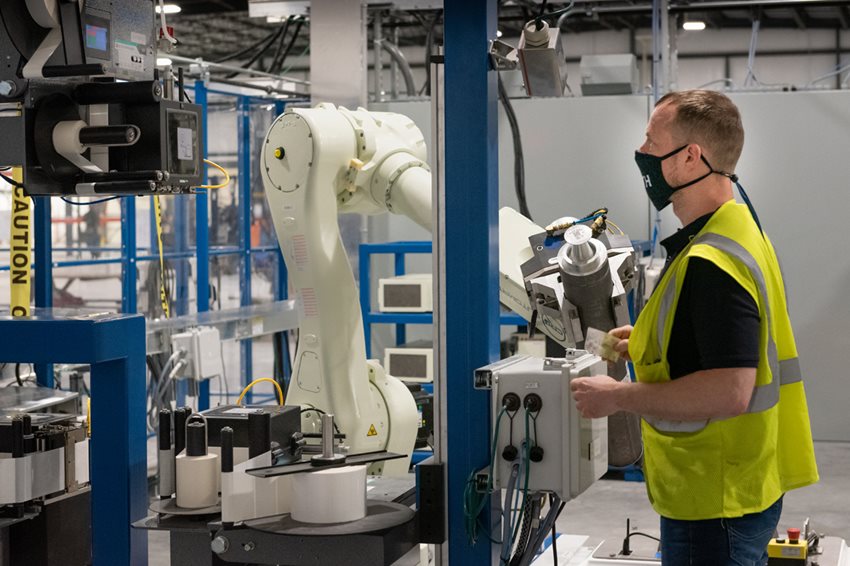“Never in my life did I ever think I’d be working with 60-year-old munitions that contain very, very dangerous chemicals,” said James DeSmet (pictured below), President & CEO of CRG Automation in Louisville, Kentucky. “That’s also an attractive part of the project. It’s a very difficult problem.”
CRG, founded 20 years ago, specializes in creating robotic and automated handling and packaging systems for products from foods and beverages to consumer goods. With 25 employees, the company is a veteran-owned small business whose clients include Wild Turkey, the famous Kentucky bourbon distiller.
So how did this 25-person company become involved in the effort to rid the U.S. of decades-old chemical weapons?
Their expertise in robotics and packaging systems provided the know-how needed by the Blue Grass Chemical Agent-Destruction Pilot Plant (BGCAPP) – the Bechtel-led team safely destroying a stockpile of munitions in nearby Richmond, Kentucky.
Seeking out partners in problem-solving
It’s the kind of business that Bechtel seeks out every day to solve difficult problems for our customers – typically spending about $14 billion dollars a year purchasing goods and services from supply chains across the world.
In this case, CRG designed and built a rocket warhead containerization system that will handle the remnants of decades-old chemical weapons at the plant in Richmond.
Bechtel leads an industry team performing the work under contract to a Pentagon office in charge of the program, called the Program Executive Office – Assembled Chemical Weapons Alternatives (PEO-ACWA).
Eradicating the remaining stockpile of U.S. chemical weapons is ACWA’s mission, fulfilling commitments to the U.S. Congress and an international treaty signed by more than 190 nations in the early 1990s.
A complex challenge

The plant in Kentucky began destroying weapons in 2019 but sought help for a new approach to destroying a certain inventory of munitions containing deadly nerve agents: M55 rockets. The rockets are more than 6 feet long and 4.4 inches in diameter and have historically been problematic. In destruction campaigns elsewhere, they were prone to leakage and corrosion and the propellant becomes unstable over time.
“Utilizing local or regional companies for products and services creates an opportunity to positively impact the economy in our area,” said Ron Hink, BGCAPP project manager. “Being geographically close can reduce shipping times, speed up delivery of equipment or components, and add improved response time for technical support.”
Since the project began, more than $185 million has been spent on Kentucky-based businesses for BGCAPP.
CRG designed, fabricated, and integrated robots, machinery, canisters, and handling systems for the portions of the plant that will seal the drained rockets in containers for eventual destruction. The company also designed and built a vertical rocket cutting system to separate the weapons’ warheads from their rocket motors. Additionally, CRG is currently working on a custom nondestructive examination (NDE) system that uses x-rays to inspect the complete M55 rocket assembly to identify problematic munitions that could create issues during normal processing.
Safer, simpler, more efficient
The challenge was to make the system safer, simpler, and more efficient. An integrated team from CRG, Bechtel, PEO-ACWA, Amentum, and others iterated through the sequence of what must happen to a munition inside the plant: How it moves from one place to the next, and what happens at each location.

Figure 2: On the CRG manufacturing floor, a robot handles a dummy rocket warhead.
With no humans in the room, the robots do the hard labor. But, DeSmet said, they are not the stars of the show.
“People are enamored with the industrial robots because they are the future coming to life. But the robots are products,” DeSmet said. “The special sauce to the robot is actually the integrator – the people doing the programming – and the person designing the end-of-arm tool, which is what actually makes contact with the product. The ballet of the movements is really what’s special.
“The robots are very stout. They’re great robots in fact. But without the programming, the end-of-arm-tools, and the know-how of what’s right and wrong, you’ve got a potential problem.”
A less is more approach
To add to the complexity, the team needed to ensure total containment of the dangerous items and minimize the need for humans to enter the room where the warheads are handled. That meant designing systems and processes requiring as few “consumables” as possible, that is, parts or pieces that must be replenished or reloaded.
The result was a process wherein one robot would be designated to pick up the drained warhead and place it in a container waiting in a special crimping machine. It would cap the container and the crimper then seals it shut. Only then does a different, “clean” robot remove the sealed container for further processing. The robots can repeat the process as many as 25 times per hour.

Figure 3: Pallets containing dummy warheads
The emptied warheads and containers are then destroyed in a sealed detonation chamber, while in another part of the plant, the nerve agent is neutralized and destroyed with sodium hydroxide and hot water.
In a sense, the challenge at BGCAPP is one CRG tackles with every customer. And it’s why Bechtel turns to specialty vendors and service providers, building a team of experts, all working to achieve a customer’s mission.
The technology of what’s possible
“Our job is to understand the technology of what’s possible,” DeSmet said. “We’ll brainstorm with a customer and they’ll have a pretty wild idea. Our job is to take an idea and run it out to figure out how you could do something like that. We like to push the technology bounds. But in cases like Blue Grass you can’t push it too far because unknown technology in an environment like this could be very bad news.”
The systems designed by CRG were tested at the Louisville facility using dummy munitions in a section of the factory floor mocked up to the exact dimensions of the room in the Blue Grass Plant.
The system successfully handed 25 munitions in 57 minutes. It’s now being installed at the Blue Grass plant. Identical systems are installed in a training facility in Richmond.

Figure 4: The BGCAPP training center in Richmond, Kentucky
After further testing, the systems will go into actual use when the plant starts the campaign to destroy the M55 rockets. They will be the final inventory in the Blue Grass stockpile.
Proud to participate
“As a military veteran myself, I personally couldn’t be more proud about being asked to participate in this project,” DeSmet said. “It was clear to the team that this was a first for Kentucky. We have friends and relatives that live in Richmond. Blue Grass will be the last demilitarization plant in the U.S. and we are in the 11th hour of this timeline.
“We’ve got to get it done. So we all feel that pressure but we’re not letting that distract us. We’re all extraordinarily proud to be a Kentuckian, to be an American, and to be involved in a project like this.”
Crown Packaging Corporation’s Equipment Division in Louisville is under contract with the U.S. Government as the primary designer and integrator of munitions handling and packaging for the Blue Grass Chemical Agent-Destruction Pilot Plant in Richmond, Kentucky, one hour and 35 minutes southeast of Louisville. Crown has reached out to multiple high-tech Kentucky companies to implement its design with state-of-the-art technology and support services that such cutting-edge systems require. CRG became a core member of the team.

